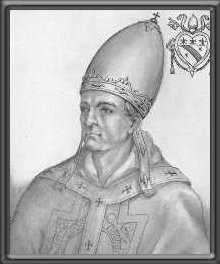Pope Nicholas IV
| Pope Nicholas IV | |
|---|---|
 | |
| Papacy began | 22 February 1288 |
| Papacy ended | 4 April 1292 |
| Predecessor | Honorius IV |
| Successor | Celestine V |
| Orders | |
| Consecration | 1281 |
| Created Cardinal |
12 March 1278 by Nicholas III |
| Personal details | |
| Birth name | Girolamo Masci |
| Born |
30 September 1227 Lisciano, Marche, Papal States, Holy Roman Empire |
| Died |
4 April 1292 (aged 64) Rome, Papal States |
| Previous post |
|
| Coat of arms |
|
| Other popes named Nicholas | |
| Papal styles of Pope Nicholas IV | |
|---|---|
 | |
| Reference style | His Holiness |
| Spoken style | Your Holiness |
| Religious style | Holy Father |
| Posthumous style | None |
Pope Nicholas IV (Latin: Nicholaus IV; 30 September 1227 – 4 April 1292), born Girolamo Masci, Pope from 22 February 1288 to his death in 1292. He was the first Franciscan to be elected pope.[1]
Biography
Early life
Masci was born at Lisciano, near Ascoli Piceno. He was a pious, peace-loving friar with no ambition save for the Church, the crusades and the extirpation of heresy. Originally a Franciscan friar, he had been legate to the Greeks under Pope Gregory X in 1272, to invite their participation in the Second Council of Lyons. He succeeded Bonaventure as Minister General of his religious order in 1274. He was made Cardinal Priest of Santa Pudenziana and Latin Patriarch of Constantinople in 1278 by Pope Nicholas III, and Cardinal Bishop of Palestrina by Pope Martin IV.[2]
Pontificate
Papal conclave
After the death of Pope Honorius IV on 3 April, 1287, the conclave held at Rome was for a time hopelessly divided in its selection of a successor. When fever had carried off six of the electors, the others, with the sole exception of Girolamo, left Rome. It was not until the following year that they reassembled and February 1288, unanimously elected him to the papacy. He became the first Franciscan pope and chose the name Nicholas IV in remembrance of Nicholas III.[2]
Actions
In regard to the question of the Sicilian succession, as feudal suzerain of the kingdom, Nicholas annulled the treaty, concluded in 1288 through the mediation of Edward I of England, which confirmed James II of Aragon in the possession of the island of Sicily. In May 1289 he crowned King Charles II of Naples and Sicily after the latter had expressly recognized papal suzerainty, and in February 1291 concluded a treaty with Kings Alfonso III of Aragon and Philip IV of France looking toward the expulsion of James from Sicily.[2]
The loss of Acre in 1291 stirred Nicholas IV to renewed enthusiasm for a crusade. He sent missionaries, among them the Franciscan John of Monte Corvino,[1] to labour among the Bulgarians, Ethiopians, Mongols, Tatars and Chinese.
Nicholas IV issued an important constitution on 18 July 1289, which granted to the cardinals one-half of all income accruing to the Holy See and a share in the financial management, thereby paving the way for that independence of the College of Cardinals which, in the following century, was to be of detriment to the papacy.
Death
Nicholas IV died 4 April 1292 in the palace, which he had built. He was buried in the Basilica di Santa Maria Maggiore.[3]
Taxatio
The 1291–92 Taxatio he initiated, which was a detailed valuation for ecclesiastical taxation of English and Welsh parish churches and prebends, remains an important source document for the mediaeval period. An edition was reprinted by the Record Commission in 1802 as Taxatio Ecclesiastica Angliae et Walliae Auctoritate.[4]
References
- ↑ 1.0 1.1 McBrien, Richard P., Live of the Popes, p.226, Harper Collins, 2000
- ↑ 2.0 2.1 2.2 Weber, Nicholas. "Pope Nicholas IV." The Catholic Encyclopedia. Vol. 11. New York: Robert Appleton Company, 1911. 29 Jan. 2015
- ↑ Richard P. McBrien, Live of the Popes, 226.
- ↑ The Taxatio Project, Humanities Research Institute, University of Sheffield
 This article incorporates text from a publication now in the public domain: Chisholm, Hugh, ed. (1911). Encyclopædia Britannica (11th ed.). Cambridge University Press.
This article incorporates text from a publication now in the public domain: Chisholm, Hugh, ed. (1911). Encyclopædia Britannica (11th ed.). Cambridge University Press.
| Catholic Church titles | ||
|---|---|---|
| Preceded by Bonaventure |
Minister General of the Order of Friars Minor 1274–1278 |
Succeeded by Bonagratia de San Giovanni in Persiceto |
| Preceded by Pope Honorius IV |
Pope 22 February 1288 – 4 April 1292 |
Succeeded by Pope Celestine V |
| ||||||||||||||||||||||||||||||||||||||||||||||||||||||||||||
| ||||||||||||||||||||||||||||||||||||||||||||||||||||||
|

